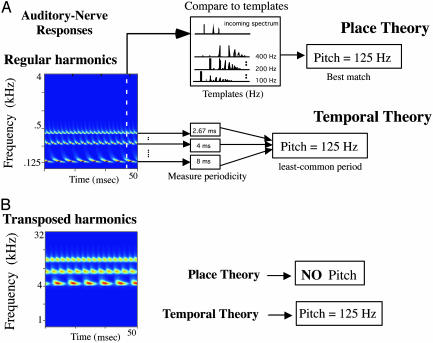Fig. 2.
Schematic of the place theory and the temporal theory of pitch. (A) Pitch theories. The pattern of activation evoked by a three-harmonic stimulus (125, 250, and 375 Hz) on the auditory nerve. The place theory assumes that the neural response pattern across the tonotopic axis (white dashed line) is compared with the patterns from a bank of harmonic templates stored in the central auditory system. Pitch is then assigned to the fundamental of the best-matching template. The temporal theory postulates that first the response periodicity is measured in parallel in all auditory-nerve channels. The pitch is then evaluated by pooling the measurements and selecting the fundamental period common to all channels (or the least common period). (B) Predictions of the place and temporal theories of the pitch of the transposed stimuli. Because the spectral pattern of these stimuli does not resemble that of any harmonic pattern, the place theory predicts no particular clear pitch percept. The temporal theory predicts an unaltered pitch percept because the temporal modulations remain well represented in the transposed tones.

